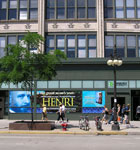Cost is a four-letter word for compromise—especially in the language of historic preservation, which architect Ellen Stoner speaks fluently. As principal of AltusWorks, a Chicago-based firm that specializes in the restoration, adaptive reuse, rehabilitation, and expansion of existing and historic structures, she’s used to balancing design with dollar signs. When the owner of a downtown Chicago office building decided to renovate a historic Louis Sullivan storefront, he turned to AltusWorks to find an elegant solution that paid tribute to the original design—without the cost of fully restoring it.

The facade of the Gage Brothers Building, on Michigan Avenue in Chicago, was designed by famed architect Louis Sullivan. In 2005, the building was renovated, and AltusWorks was charged with finding a fitting restoration tactic for the facade.
Backgrounder/
Located in Chicago’s central business district at 18, 24, and 30 S. Michigan Ave., the Gage Group Buildings are a trio of buildings designed for three hat-making companies in the late 19th century by Holabird & Roche. Situated across the street from Millennium Park, the tallest of the buildings is 18 S. Michigan, known previously as the Gage Brothers and Company Building. Twelve stories high, it was built in 1899 and featured an ornamental façade designed by famed Chicago architect Louis Sullivan, who also designed a cast-iron storefront on the building’s ground floor. Because it had fallen into disrepair, the storefront was removed in the 1950s and subsequently replaced by a modern granite surround with a recessed glass storefront.
“In 2005, the owner embarked on a comprehensive condo-conversion of the building,” says Stoner, who founded AltusWorks in 2003 and now oversees a team of eight architects. “As the owner was looking at the building, he really wanted to make it look more appropriate to how it originally was designed. Unfortunately, he had done previous studies about recreating the original storefront and found it was cost-prohibitive.”

This is the final result of AltusWorks’s extensive study of Louis Sullivan’s original storefront. The team stripped the storefront of its Sullivan-esque details and presented the original design's base geometry.
Challenge/
AltusWorks was asked to renovate the Louis Sullivan storefront in a way that honored Sullivan’s original design without the expense of restoring it.
Solution/
AltusWorks began by conducting a feas-ibility study on behalf of the building owner. “Because recreation was cost-prohibitive, we needed to understand what the other options were that fit within the budget but would still meet the design intent of the late 1800s,” Stoner says. Ultimately, the client chose a stripped-down approach: Although Louis Sullivan was famous for his ornamental designs—elaborate embellishments in the form of tangled scrolls and floral motifs—AltusWorks proposed stripping the storefront of its Sullivan-esque details and instead honoring them with the base geometry underlying the original design.
“We looked at three different design solutions in varying price ranges and with different levels of detail,” Stoner says. “Ultimately, the design we chose deconstructed the Louis Sullivan design back to the basic geometric forms he used as a basis. We stripped off all the ornament, which he is really known for, and found the squares, rectangles, circles, and different radii that he’d used to construct the storefront. The client opted to strip that back even further, and we ultimately went for a base panel structure that recreated the storefront’s original proportion of scales.”
One reason for replacing the original store-front in the 1950s, Stoner hypothesizes, was corrosion. “Sullivan storefronts are difficult to maintain due to the three-dimensional nature of the detailing,” she says. “Water had many places to sit and corrode the system, creating pathways behind the panels, which further contributed to the deterioration and compromised the anchorage system.”
To avoid recreating the storefront’s original problems, AltusWorks looked carefully at different material choices. Instead of cast iron, like the original, it ultimately chose locally sourced cast aluminum, which is more sustainable—aluminum is the most abundant metal in the Earth’s crust and can be infinitely recycled without degradation of properties—and also more resilient thanks to its natural corrosion resistance.
“We ended up with cast aluminum for many reasons: its cost, its thermal properties, its movement, its durability, its ability to take paint, and its ability to sustain the Chicago weather, including the extremes of heat and cold and also the large amount of salt they get being on Michigan Avenue,” Stoner says.

This diagram shows the structural system designed to support the new cast aluminum surround and curtainwall glazing system.
AltusWorks collaborated with a storefront fabricator to design and assemble the storefront. “He basically designed the armament, which supported the aluminum panels,” Stoner says. “He knew all the thermal characteristics of aluminum and how to attach them to the armament while still maintaining a watertight skin at the structural level.” The biggest challenge wasn’t assembly, however. It was design, which required a great deal of research at local museums, studying historical remnants and photos for the purpose of learning, understanding, and respecting Sullivan’s approach and aesthetic.
“To have the opportunity to work on such a prominent element designed by Louis Sullivan is a great honor,” says Stoner, who had to receive design approval from two preservation organizations: Landmarks Illinois, which holds a façade easement on the property, and the City of Chicago’s Commission on Landmarks, which must approve all designs within Chicago’s Historic Michigan Avenue Boulevard District, where the Gage Group Buildings are located. “We wanted to be very sensitive. We were very careful not to impose our design, or our signature on his building. We wanted to respect his design intent so that if someone were looking at the building they’d say, ‘Oh yeah, I see that’s a Louis Sullivan component,’ although it’s not the original piece.”

